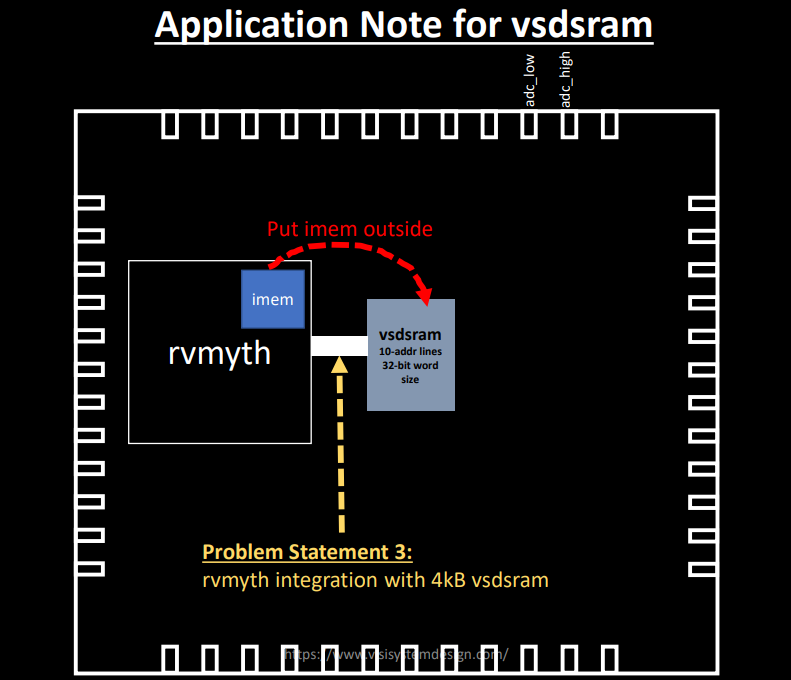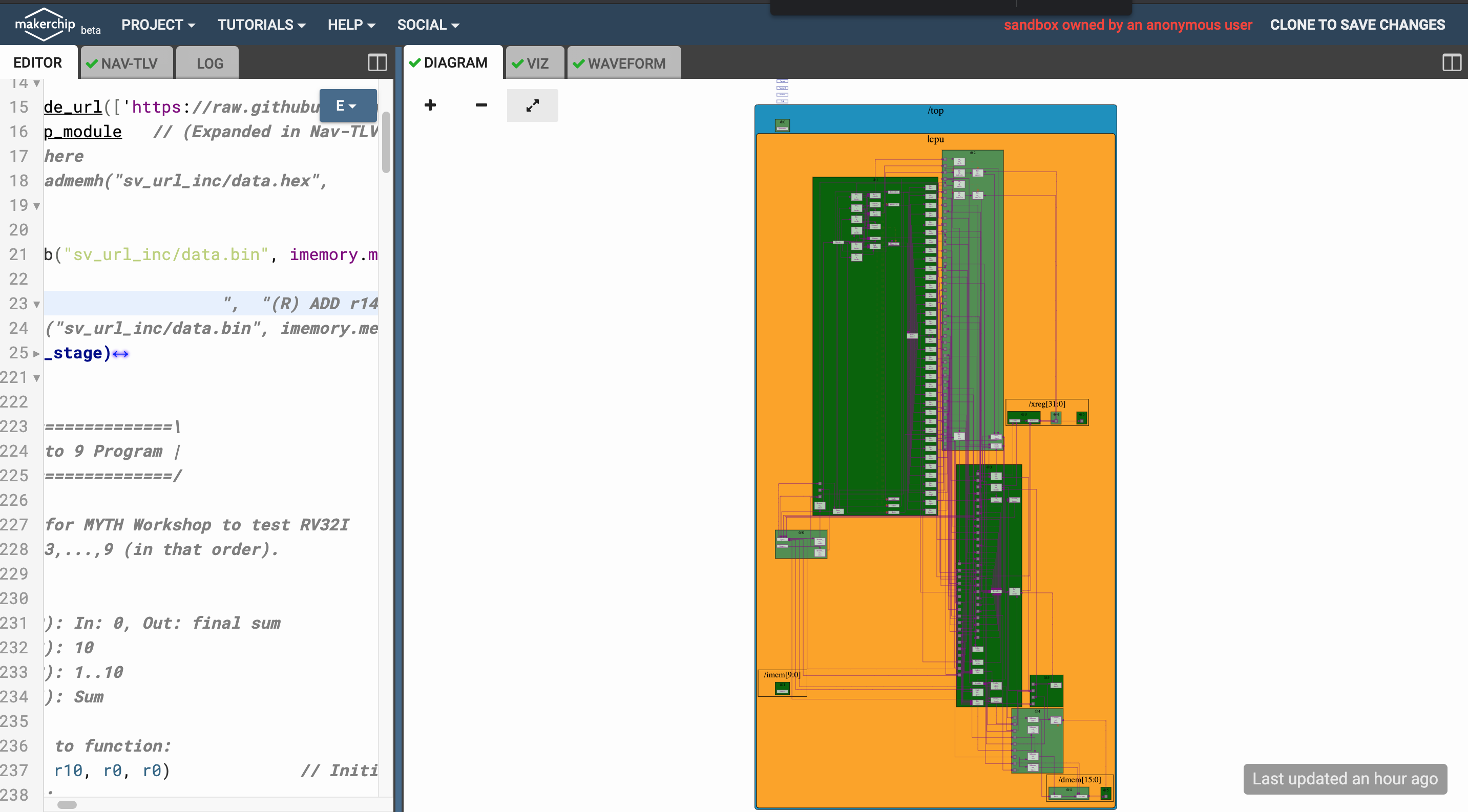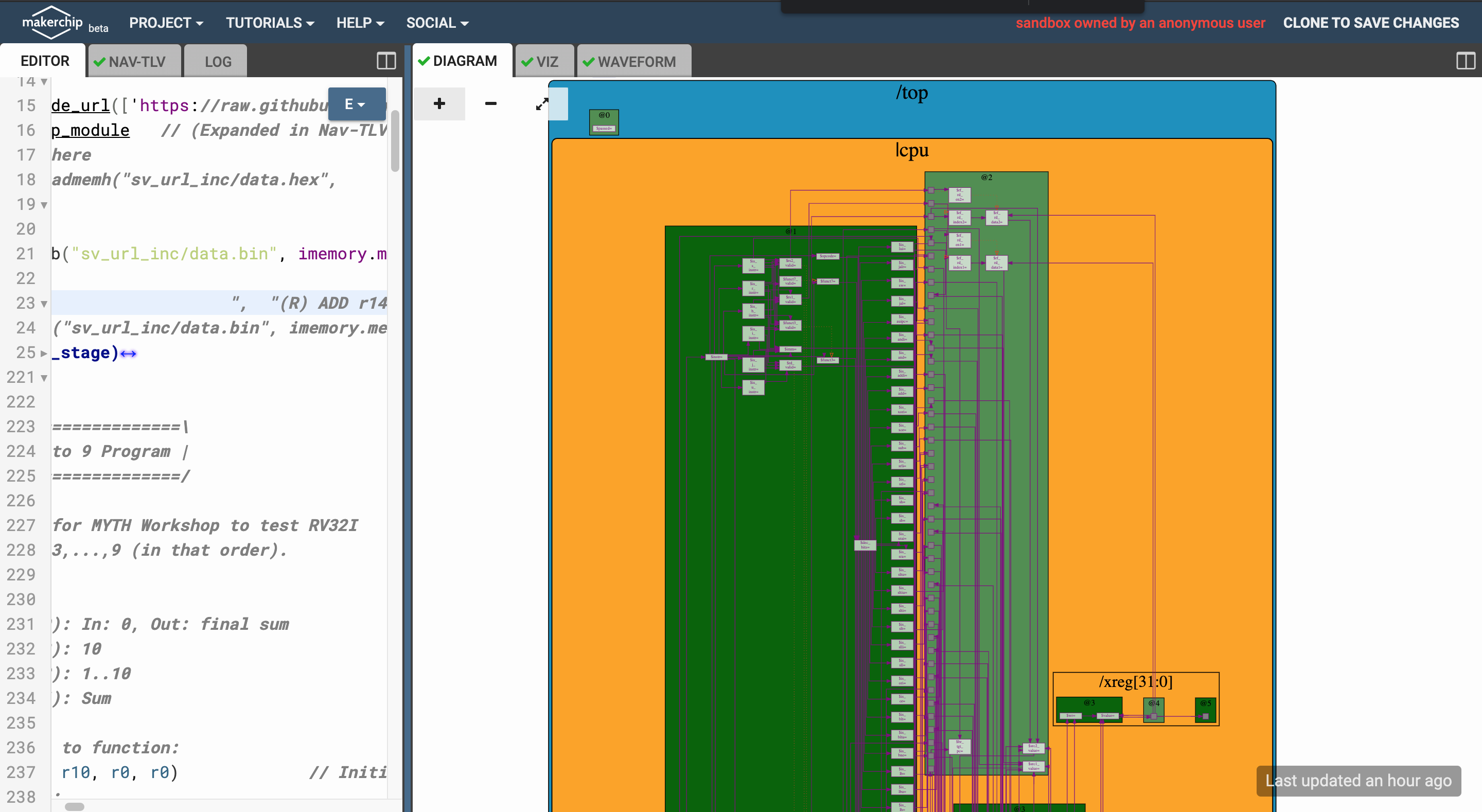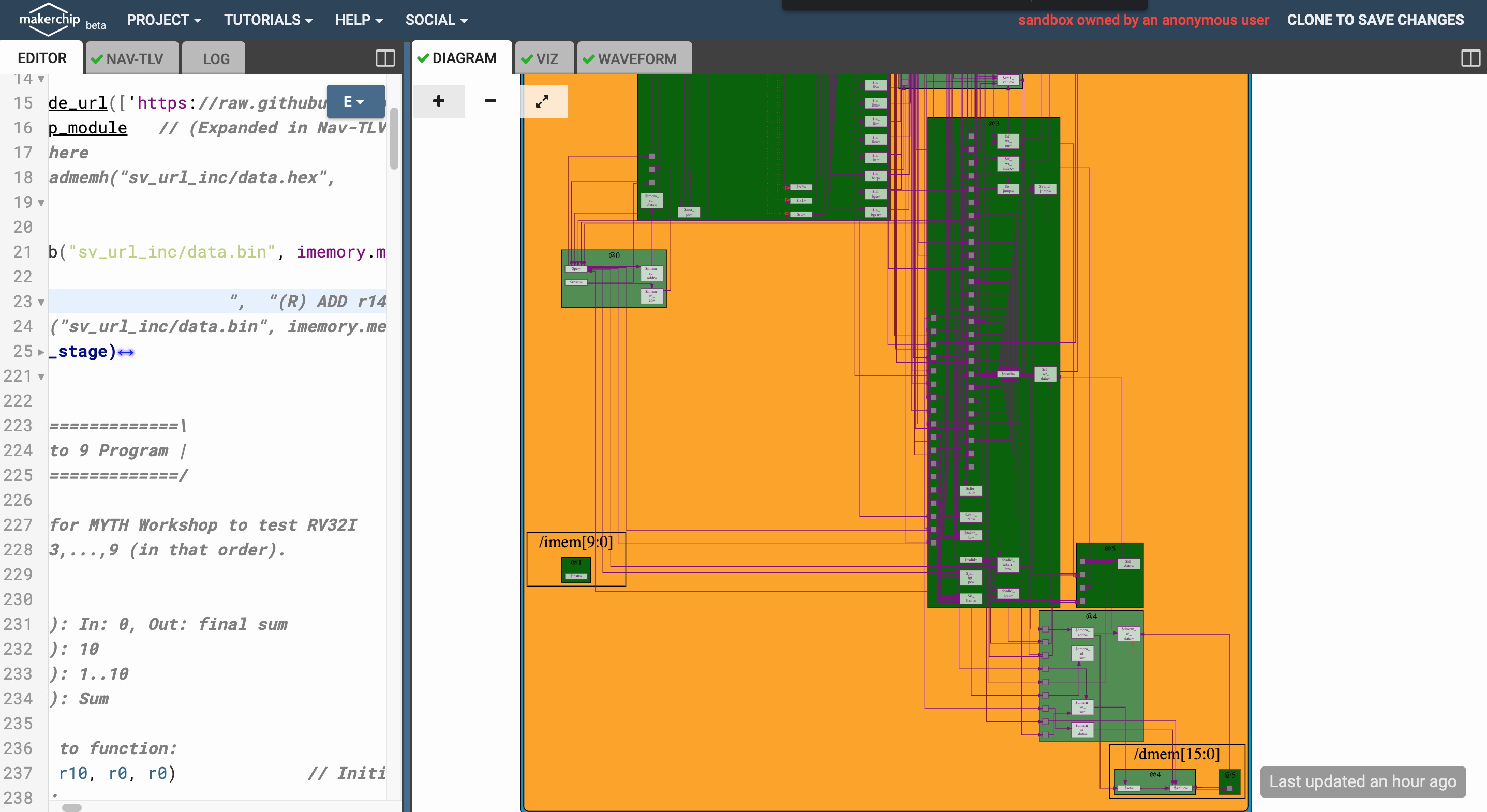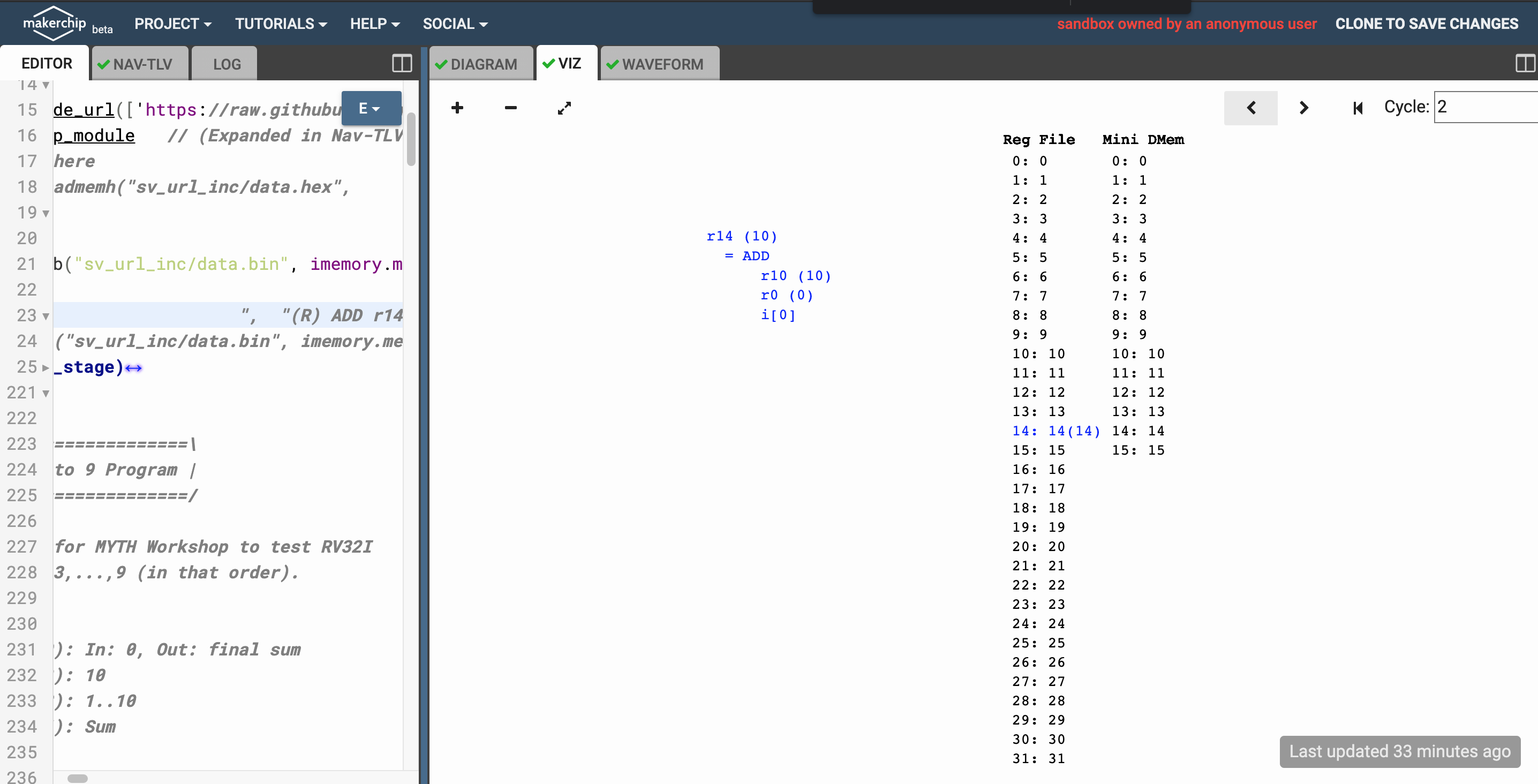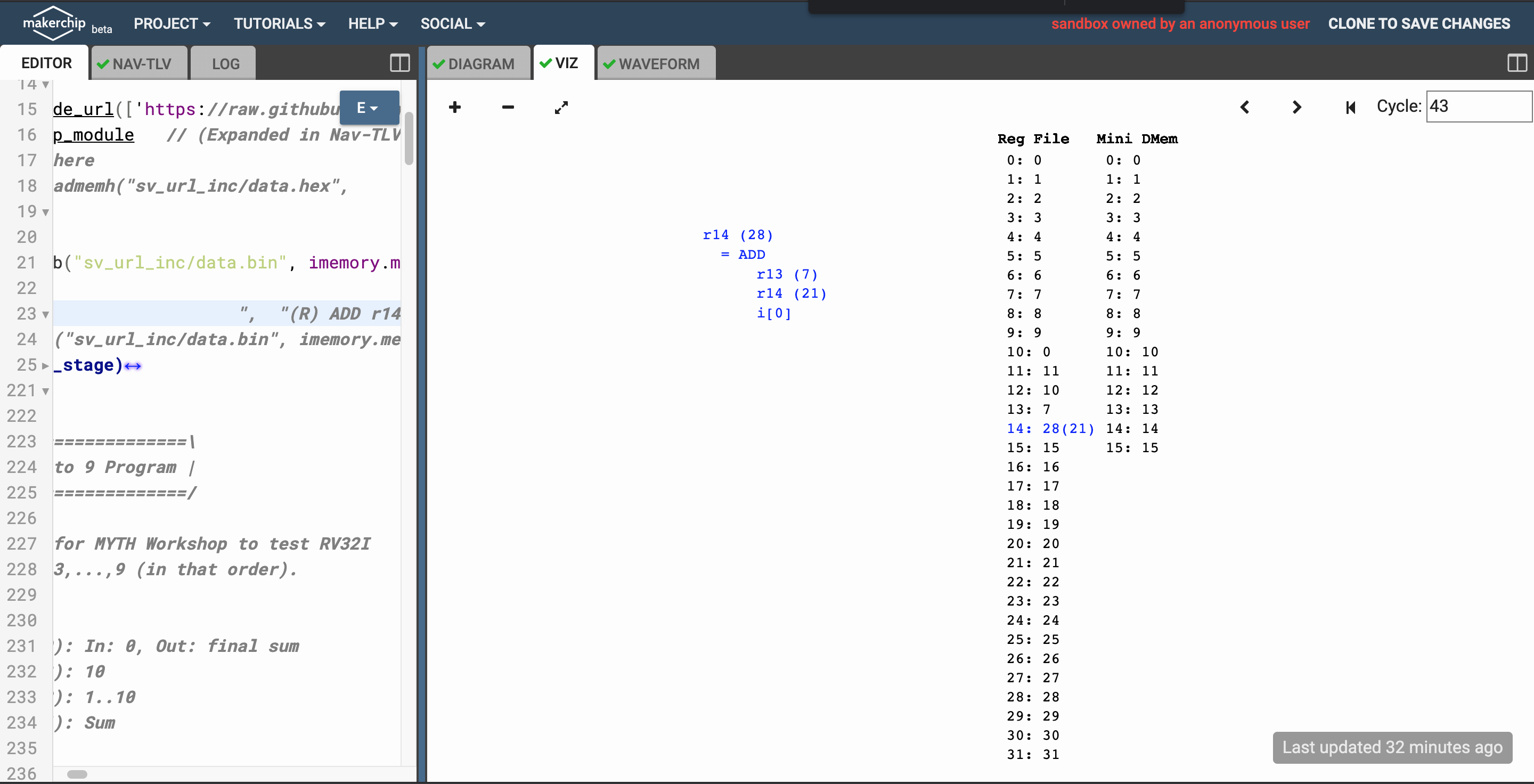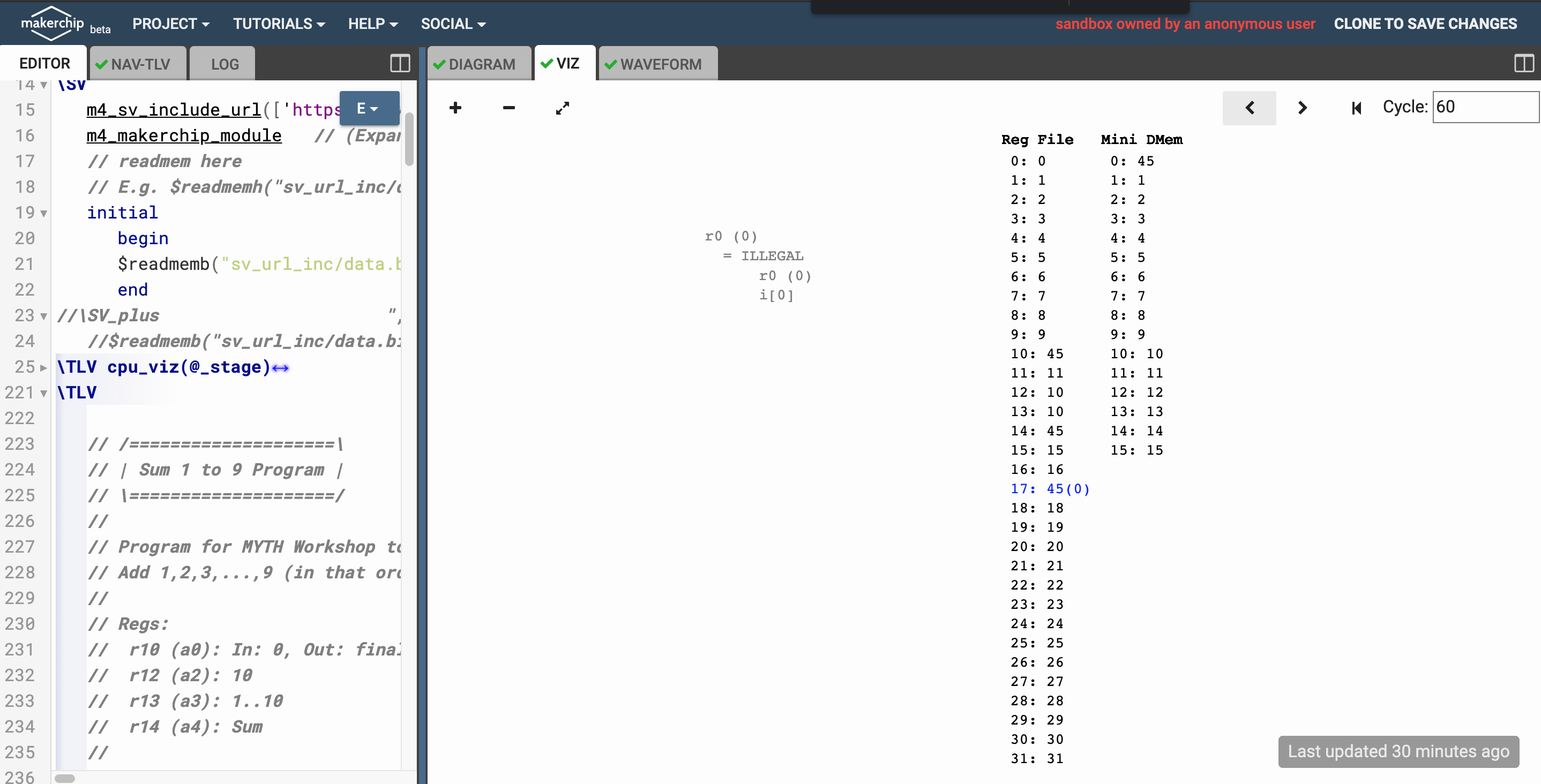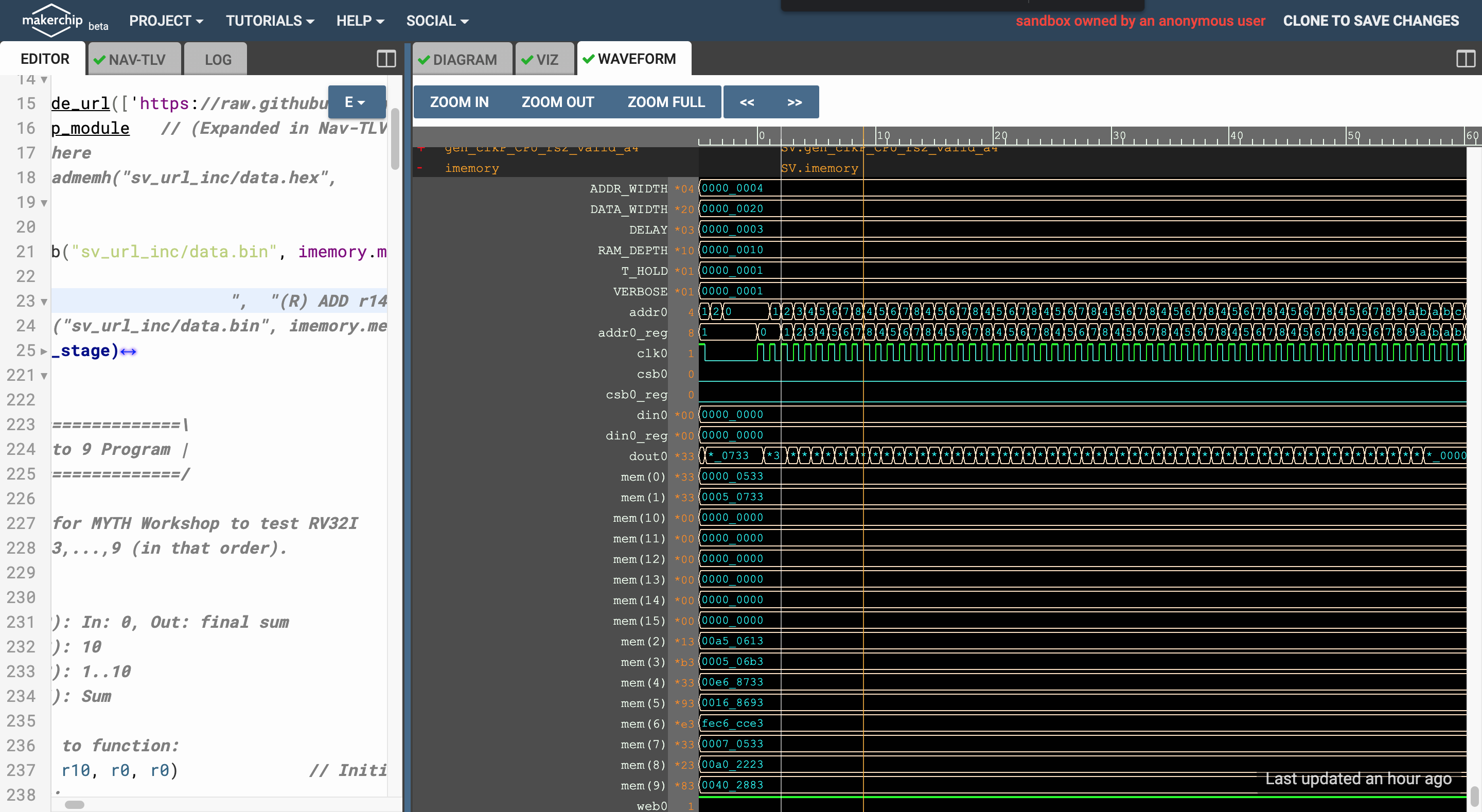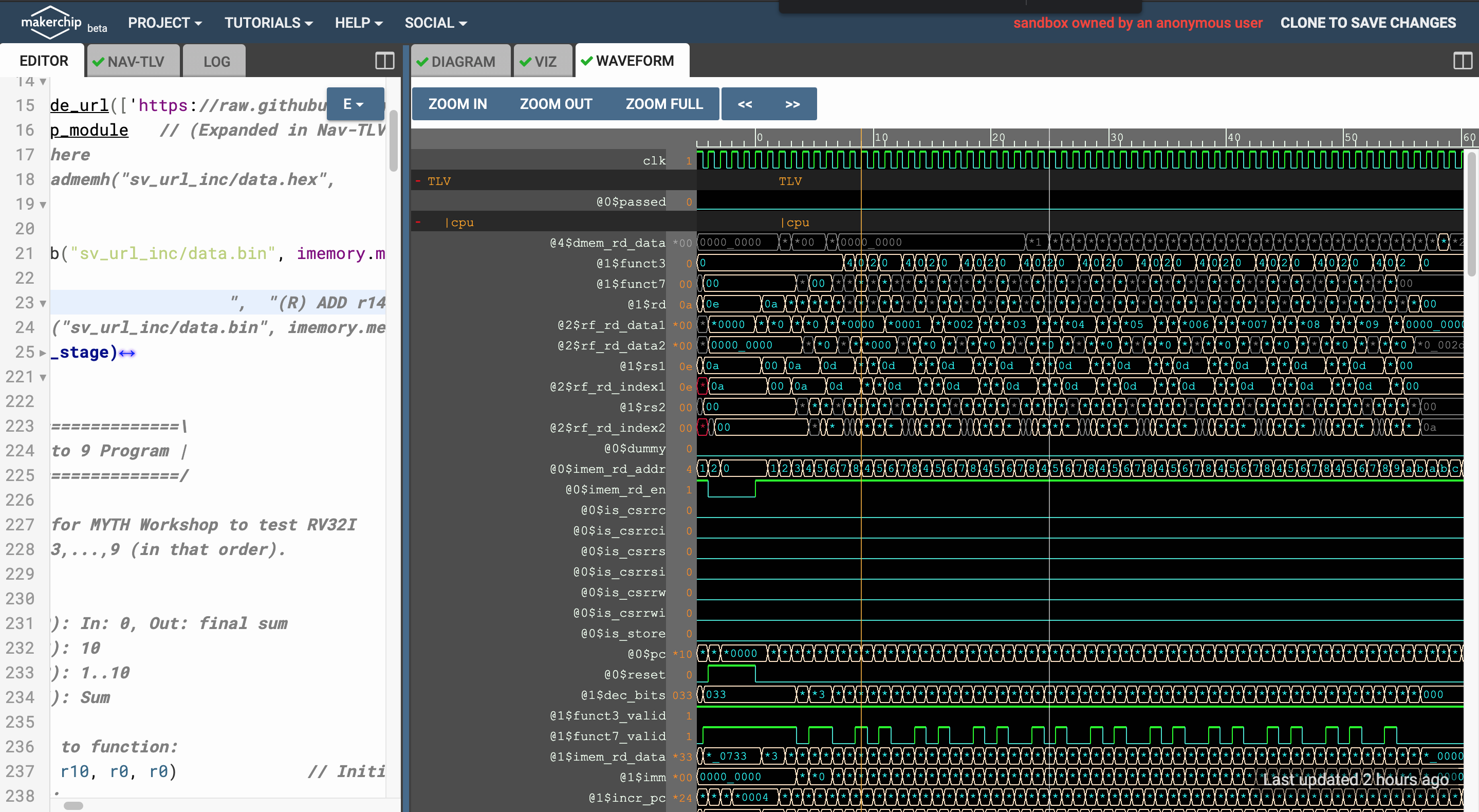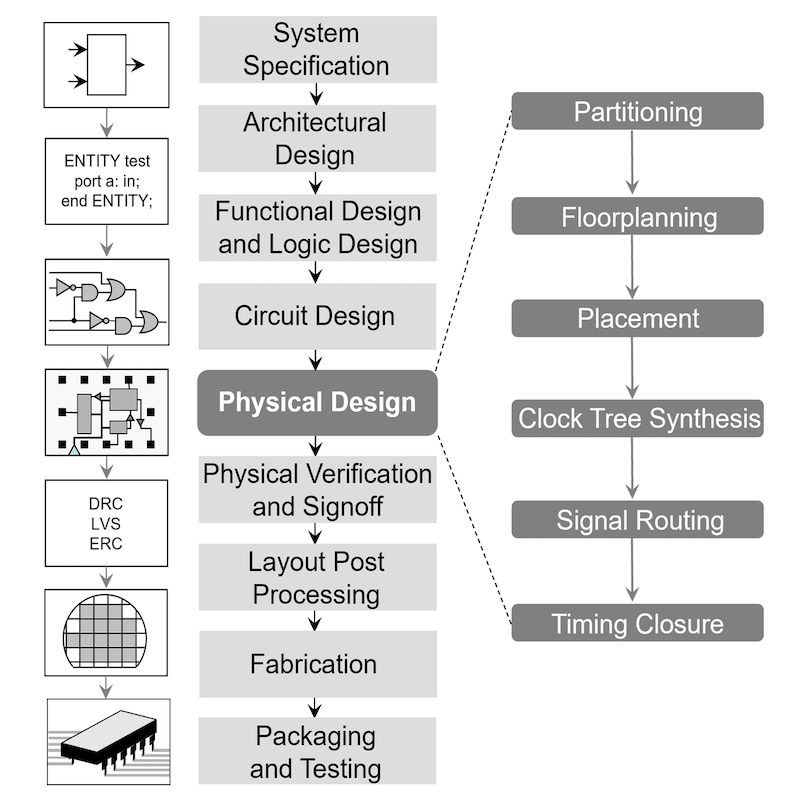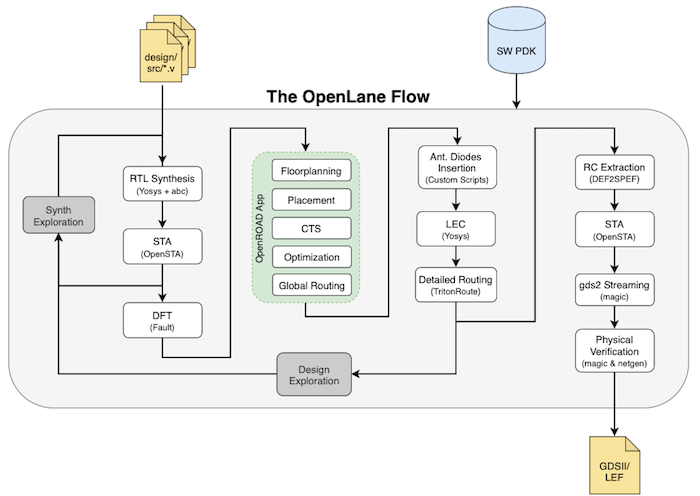VSDMemSoC is a small SoC including a RISCV-based processor named RVMYTH and an external 4kB SRAM Instruction Memory (IMem) to separate the processor core and the IMem.
- Introduction to the VSDMemSoC
- VSDMemSoC Modeling
- OpenLANE
- Post-synthesis simulation
- VSDMemSoC Physical Design
- Future works
- Contributors
- Acknowledgements
VSDMemSoC is a small yet powerful RISCV-based SoC. The main purpose of designing such an SoC is to demonstrate the concept of separating the main core and memories of a processor. This would help to make the RISC-V more modular and portable. Here, the instruction memory is separated
This work discusses the different aspects of designing a small SoC based on RVMYTH (a RISCV-based processor). This SoC will leverage an 4kB external SRAM as the instruction memory where the program is loaded from. At the end of the day, it is possible to use this small fully open-source and well-documented SoC which has been fabricated under Sky130 technology, for educational purposes.
An SoC is a single-die chip that has some different IP cores on it. These IPs could vary from microprocessors (completely digital) to 5G broadband modems (completely analog). Here we have a RISC-V core and an SRAM that makes it an IP-based mixed-signal system
RVMYTH core is a simple RISCV-based CPU, introduced in a workshop by RedwoodEDA and VSD. During a 5-day workshop students (including middle-schoolers) managed to create a processor from scratch. The workshop used the TLV for faster development. All of the present and future contributions to the IP will be done by students and under open-source licenses.
An SRAM is a type of random-access memory (RAM) that uses latching circuitry (flip-flop) to store each bit. It is a volatile memory where data is lost when power is removed. It is typically used for the cache and internal registers of a CPU as it very fast but expensive. The SRAM here is a 4 kB 6-transistor type with a 10-bit address bus and 32-bit data bus.
Here we are going to model and simulate the VSDMemSoC using makerchip.com. It is an environment that the code is written in TL-Verilog which is a simplified Some initial input signals will be fed into vsdmemsoc module that make the pll start generating the proper CLK for the circuit. The clock signal will make the rvmyth to execute instructions in its imem. As a result the register r17 will be filled with some values cycle by cycle. This simulation is stopped when the value equals 45 and passed become true. So we have 2 main elements (IP cores) and a wrapper as an SoC and there would be also a testbench module that would be used to load the program we want to run externally to the SRAM.
Please note that in the following sections we will mention some repos that we used to model the SoC. However the main source code is resided in Source-Code Directory and these modules are in Modules Sub-Directory.
As we mentioned in What is RVMYTH section, RVMYTH is designed and created by the TL-Verilog language. So we need a way for compile and trasform it to the Verilog language and use the result in our SoC. Here the sandpiper-saas could help us do the job.
Here is the repo we used as a reference to model the RVMYTH. It also contains additional information on the RISC-V core and SRAM as separate modules.
OpenRAM is an open-source Python framework to create the layout, netlists, timing and power models, placement and routing models, and other views necessary to use SRAMs in ASIC design. It supports integration in both commercial and open source flows with both predictive and fabricable technologies. We use a 32-bit word size and 10-bit address space which means there are 1024 words.
In this section we will walk through the whole process of modeling the VSDMemSoC in details. We will increase/decrease the digital output value and feed it to the DAC model so we can watch the changes on the SoC output. Please, note that the following commands are tested on the Ubuntu Bionic (18.04.5) platform and no other OSes.
- First we need to install some important packages:
$ sudo apt install make python python3 python3-pip git iverilog gtkwave docker.io
$ sudo chmod 666 /var/run/docker.sock
$ cd ~
$ pip3 install pyyaml click sandpiper-saas
- Now we can clone this repository in an arbitrary directory (we'll choose home directory here):
$ cd ~
$ git clone https://github.com/mufuteevc/VSDMemSoC.git
- It's time to make the pre-synthesis simulation:
$ cd VSDMemSoC
$ make pre_synth_sim
- We can see the waveforms by doing the following:
1) Go to makerchip.com/sandbox
2) Copy the *.v file generated by the previous command and paste it in the editor
3) Compile (or Ctrl+E)
ADD, r10, r0, r0 // Initialize r10 (a0) to 0. // Function: ADD, r14, r10, r0 // Initialize sum register a4 with 0x0 ADDI, r12, r10, 1010 // Store count of 10 in register a2. ADD, r13, r10, r0 // Initialize intermediate sum register a3 with 0 // Loop: ADD, r14, r13, r14 // Incremental addition ADDI, r13, r13, 1 // Increment intermediate register by 1 BLT, r13, r12, 1111111111000 // If a3 is less than a2, branch to label named ADD, r10, r14, r0 // Store final result to register a0 so that it can be read by main program
SW, r0, r10, 100 LW, r17, r0, 100
The little program we are running is shown above which sums 1 to 9: 45. There are three outputs: Diagram, Visualization 'VIZ' and Waveform. The most important signal here is the value in the R17 register as this is where we store the final value of the sum program we are running and check to see if it equals the value we want. Here is the final result of the modeling process:
The diagrams are described first. Diagram 1 is the full system. It is a 5-stage pipelined RISCV system. The largest block at the top-left is the CPU-core that contains the ALU operations @1. To its immediate right is the logic to separate the instructions into src, dest, targets, etc @2. The smaller bock to its right is registers which are used in stages 3 and 5. @3 is also where the results are computed at the next block. You write into DMEM in @4 and load from it @5. Diagram 2 is just a bigger version of the CPU so it is more visible while diagram 3 clearly shows the IMEM and how it has been separated from the rest of the core.
Next are the visualizations of the contents of the 32-bit registers. They are shown in cycle 2, 43 and 60 respectively. It is seen that at the final cycles, r10 and r14 contain 45 (1+2+3...9) and the simulation halts.
We describe the waveforms last. In these three pictures, we can see some signals: CLK, out, etc.
OpenLANE is an automated RTL to GDSII flow based on several components including OpenROAD, Yosys, Magic, Netgen, Fault, SPEF-Extractor and custom methodology scripts for design exploration and optimization. The main usage of OpenLANE in this project is for VSDMemSoC Physical Design. However, we need OpenLANE for the synthesis and STA process in the Post-synthesis simulation section. So we'll talk about its installation process here and let the details be until the VSDMemSoC Physical Design section.
The OpenLANE and sky130 installation can be done by following the steps in this repository https://github.com/nickson-jose/openlane_build_script.
-
More information on OpenLANE can be found in the following repositories:
https://github.com/The-OpenROAD-Project/OpenLanehttps://github.com/efabless/openlane
To summarize the installation processes:
$ git clone https://github.com/The-OpenROAD-Project/OpenLane.git
$ cd OpenLane/
$ make openlane
$ make pdk
$ make test
For more info please refer to the GitHub repositories.
NOTE Do not use sudo with any of the commands. Iur docker image version is 2021.09.09_03.00.48.
First step in the design flow is to synthesize the generated RTL code and after that we will simulate the result. This way we can find more about our code and its bugs. So in this section we are going to synthesize our code then do a post-synthesis simulation to look for any issues. The post and pre (modeling section) synthesis results should be identical.
- In OpenLANE the RTL synthesis is performed by
yosys. - The technology mapping is performed by
abc. - Finally, the timing reports for the synthesized netlist are generated by
OpenSTA.
To perform the synthesis process do the following:
$ cd ~/VSDMemSoC
$ make synth
The heavy job will be done by the script. When the process has been done, we can see the result in the output/synth/vsdmemsoc.synth.v file.
=== vsdmemsoc ===
Number of wires: 10055
Number of wire bits: 12235
Number of public wires: 10055
Number of public wire bits: 12235
Number of memories: 0
Number of memory bits: 0
Number of processes: 0
Number of cells: 12161
sky130_fd_sc_hd__a2111oi_0 50
sky130_fd_sc_hd__a211o_2 1
sky130_fd_sc_hd__a211oi_1 44
sky130_fd_sc_hd__a21boi_0 9
sky130_fd_sc_hd__a21o_2 9
sky130_fd_sc_hd__a21oi_1 1020
sky130_fd_sc_hd__a221o_2 19
sky130_fd_sc_hd__a221oi_1 282
sky130_fd_sc_hd__a22o_2 49
sky130_fd_sc_hd__a22oi_1 557
sky130_fd_sc_hd__a2bb2oi_1 1
sky130_fd_sc_hd__a311oi_1 3
sky130_fd_sc_hd__a31o_2 4
sky130_fd_sc_hd__a31oi_1 972
sky130_fd_sc_hd__a32o_1 1
sky130_fd_sc_hd__a32oi_1 3
sky130_fd_sc_hd__and2_2 24
sky130_fd_sc_hd__clkinv_1 1132
sky130_fd_sc_hd__dfxtp_1 2062
sky130_fd_sc_hd__lpflow_inputiso0p_1 1
sky130_fd_sc_hd__maj3_1 1
sky130_fd_sc_hd__mux2i_1 10
sky130_fd_sc_hd__nand2_1 1479
sky130_fd_sc_hd__nand3_1 536
sky130_fd_sc_hd__nand3b_1 6
sky130_fd_sc_hd__nand4_1 228
sky130_fd_sc_hd__nor2_1 1025
sky130_fd_sc_hd__nor3_1 103
sky130_fd_sc_hd__nor3b_1 8
sky130_fd_sc_hd__nor4_1 61
sky130_fd_sc_hd__o2111a_1 4
sky130_fd_sc_hd__o2111ai_1 12
sky130_fd_sc_hd__o211a_1 2
sky130_fd_sc_hd__o211ai_1 93
sky130_fd_sc_hd__o21a_1 22
sky130_fd_sc_hd__o21ai_0 1874
sky130_fd_sc_hd__o21bai_1 21
sky130_fd_sc_hd__o221ai_1 33
sky130_fd_sc_hd__o22ai_1 260
sky130_fd_sc_hd__o2bb2ai_1 2
sky130_fd_sc_hd__o311ai_0 8
sky130_fd_sc_hd__o31a_2 2
sky130_fd_sc_hd__o31ai_1 27
sky130_fd_sc_hd__o32ai_1 2
sky130_fd_sc_hd__o41ai_1 4
sky130_fd_sc_hd__or2_2 21
sky130_fd_sc_hd__or4_2 1
sky130_fd_sc_hd__xnor2_1 16
sky130_fd_sc_hd__xor2_1 56
sram_32_1024_sky130A 1
In integrated circuit design, physical design is a step in the standard design cycle which follows after the circuit design. At this step, circuit representations of the components (devices and interconnects) of the design are converted into geometric representations of shapes which, when manufactured in the corresponding layers of materials, will ensure the required functioning of the components. This geometric representation is called integrated circuit layout. This step is usually split into several sub-steps, which include both design and verification and validation of the layout.
Here is the picture of the OpenLANE architecture:
OpenLANE flow consists of several stages. By default all flow steps are run in sequence. Each stage may consist of multiple sub-stages. Lots of info about the flow and its internal tools can be found Here.
- This link contains info about how to run OpenLANE in
interactivemode. - This link contains info about different variables for configuration.
- This link contains info about building hard macros using OpenLANE.
We'll leverage info of these links during the project to build the VSDBabySoC layout.
Although OpenLANE integrates all required tools in its flow, sometimes we need to use a toolset direcltly from our host OS/Ubuntu. As an example it is not possible to open GUI of the Magic VLSI Layout software from the OpenLANE docker container due to container command line nature. So we need to install the tool on our main OS/Ubuntu and open it from there (not the container).
Magic is a venerable VLSI layout tool, written in the 1980's at Berkeley by John Ousterhout, now famous primarily for writing the scripting interpreter language Tcl. Due largely in part to its liberal Berkeley open-source license, magic has remained popular with universities and small companies. The open-source license has allowed VLSI engineers with a bent toward programming to implement clever ideas and help magic stay abreast of fabrication technology. However, it is the well thought-out core algorithms which lend to magic the greatest part of its popularity. Magic is widely cited as being the easiest tool to use for circuit layout, even for people who ultimately rely on commercial tools for their product design flow. Here is how to install it on a machine.
Here we are going to implement a fully digital design using OpenLANE. This way we can get our hands dirty and learn a lot about the OpenLANE flow. Implementing mixed-signal layout without gathering knowledge of this step is pretty much tough.
We are using OPENLANE_PATH environment variable to reference the OpenLANE installed directory. As an example imagine we have installed the OpenLANE in the ~/OpenLane directory, so the value of the OPENLANE_PATH variable would be ~/OpenLane. This value should be changed in the Makefile before any progress.
We have provided minimum required configurations in this file. However, the file could be changed accorting to other requirements. This file will be copied directly to the OpenLANE designs/rvmyth folder for layout implementation.
The RVMYTH layout generation flow could be all started by the following command.
$make rvmyth_layout
The script will take care of the rest of the process. The process should take about 20mins depending on the PC/laptop hardware configurations. After that results can be found in the output/rvmyth_layout folder.
The following command will produce a file named post_routing_sim.vcd which can be used to simulate post-routing and powered model.
$make rvmyth_post_routing_sim
$gtkwave out/rvmyth_layout/post_routing_sim.vcd
Here is the result.
As it can be seen the result is exactly the same as the previous results.
In this step we are going to do STA on the RVMYTH design. First we should create a timing database that we will query for STA. Follow the instructions:
$make mount
$./flow.tcl -design rvmyth -tag rvmyth_test -interactive | tee /VSDMemSoC/output/rvmyth_layout/sta.log
%openroad
%read_lef designs/rvmyth/runs/rvmyth_test/tmp/merged.lef
%read_def designs/rvmyth/runs/rvmyth_test/results/cts/rvmyth.cts.def
%write_db designs/rvmyth/runs/rvmyth_test/rvmyth.db
Now we can query the database and excract the STA out of it by the following commands (NOTE that we are still in OpenROAD environment o/w we should re-enter the environment):
%read_db designs/rvmyth/runs/rvmyth_test/rvmyth.db
%read_verilog designs/rvmyth/runs/rvmyth_test/results/lvs/rvmyth.lvs.powered.v
%read_liberty $::env(LIB_SYNTH_COMPLETE)
%link_design rvmyth
%read_sdc scripts/base.sdc
%set_propagated_clock [all_clocks]
%report_checks -path_delay min_max -format full_clock_expanded -digits 4
%exit
%exit
$exit
Here is the min_max analysis result:
Startpoint: _09644_ (rising edge-triggered flip-flop clocked by CLK)
Endpoint: _09612_ (rising edge-triggered flip-flop clocked by CLK)
Path Group: CLK
Path Type: min
Delay Time Description
-------------------------------------------------------------
0.0000 0.0000 clock CLK (rise edge)
0.0000 0.0000 clock source latency
0.0100 0.0100 ^ CLK (in)
0.1302 0.1402 ^ clkbuf_0_CLK/X (sky130_fd_sc_hd__clkbuf_16)
0.2797 0.4199 ^ clkbuf_4_7_0_CLK/X (sky130_fd_sc_hd__clkbuf_1)
0.2127 0.6326 ^ clkbuf_leaf_21_CLK/X (sky130_fd_sc_hd__clkbuf_16)
0.0000 0.6326 ^ _09644_/CLK (sky130_fd_sc_hd__dfxtp_1)
0.3158 0.9484 v _09644_/Q (sky130_fd_sc_hd__dfxtp_1)
0.0000 0.9484 v _09612_/D (sky130_fd_sc_hd__dfxtp_2)
0.9484 data arrival time
0.0000 0.0000 clock CLK (rise edge)
0.0000 0.0000 clock source latency
0.0100 0.0100 ^ CLK (in)
0.1302 0.1402 ^ clkbuf_0_CLK/X (sky130_fd_sc_hd__clkbuf_16)
0.4999 0.6401 ^ clkbuf_4_12_0_CLK/X (sky130_fd_sc_hd__clkbuf_1)
0.2775 0.9176 ^ clkbuf_leaf_42_CLK/X (sky130_fd_sc_hd__clkbuf_16)
0.0000 0.9176 ^ _09612_/CLK (sky130_fd_sc_hd__dfxtp_2)
0.0000 0.9176 clock reconvergence pessimism
-0.0434 0.8741 library hold time
0.8741 data required time
-------------------------------------------------------------
0.8741 data required time
-0.9484 data arrival time
-------------------------------------------------------------
0.0743 slack (MET)
Startpoint: _09572_ (rising edge-triggered flip-flop clocked by CLK)
Endpoint: OUT[5] (output port clocked by CLK)
Path Group: CLK
Path Type: max
Delay Time Description
-------------------------------------------------------------
0.0000 0.0000 clock CLK (rise edge)
0.0000 0.0000 clock source latency
0.0100 0.0100 ^ CLK (in)
0.1302 0.1402 ^ clkbuf_0_CLK/X (sky130_fd_sc_hd__clkbuf_16)
0.6871 0.8273 ^ clkbuf_4_8_0_CLK/X (sky130_fd_sc_hd__clkbuf_1)
0.2944 1.1217 ^ clkbuf_leaf_97_CLK/X (sky130_fd_sc_hd__clkbuf_16)
0.0000 1.1217 ^ _09572_/CLK (sky130_fd_sc_hd__dfxtp_1)
0.3045 1.4261 ^ _09572_/Q (sky130_fd_sc_hd__dfxtp_1)
0.1444 1.5706 ^ output7/X (sky130_fd_sc_hd__clkbuf_2)
0.0000 1.5706 ^ OUT[5] (out)
1.5706 data arrival time
20.0000 20.0000 clock CLK (rise edge)
0.0000 20.0000 clock network delay (propagated)
0.0000 20.0000 clock reconvergence pessimism
-4.0000 16.0000 output external delay
16.0000 data required time
-------------------------------------------------------------
16.0000 data required time
-1.5706 data arrival time
-------------------------------------------------------------
14.4294 slack (MET)
The report can be found in output/rvmyth_layout/sta.log file.
To see the final GDSII layout, we must first change directory to output/rvmyth_layout/rvmyth_test/results/magic (because we need to access .magicrc file) and then open the rvmyth.gds file by magic software. So here it is:
$cd ~/VSDMemSoC
$cd output/rvmyth_layout/rvmyth_test/results/magic
$magic rvmyth.gds
Now here is the final result of the RVMYTH GDSII layout.
As we know VSDBabySoC is a small mixed-signal SoC that contains a PLL, a DAC, and a RISCV-based processor named RVMYTH. All of these IP cores -from digital to analog- brought to us by VLSI-System-Design (VSD) students which shows a greate potential in the community. Two main contributions of this work are:
- Building the SoC all around the student wroks.
- Automating mixed-signal physical design flow by open-source tools (i.e. OpenLANE).
In this section we are going to talk about how to implement our design, in detail.
To start physical design process of a mixed-signal chip by the OpenLANE flow we need to provide three files per each analog IP. OpenLANE will use these informations to create final GDSII layout. Here they are:
The .lib file is an ASCII representation of the timing and power parameters associated with any cell in a particular semiconductor technology The timing and power parameters are obtained by simulating the cells under a variety of conditions and the data is represented in the .lib format The .lib file contains timing models and data to calculate
- I/O delay paths
- Timing check values
- Interconnect delays
I/O path delays and timing check values are computed on a per-instance basis. Reference
In mixed-signal design, we instantiate the analog IP cores (e.g. PLL and DAC) as a black-box, and the synthesizer and STA tool will use .lib info to do their tasks. Unfortunately, there is no free open-source tools to extract the timing and power info from the final spice model. So we'll use a fake .lib file for our IP cores that will be generated by a perl script.
GDSII stream format, common acronym GDSII (or GDS), is a database file format which is the de facto industry standard for data exchange of integrated circuit or IC layout artwork. It is a binary file format representing planar geometric shapes, text labels, and other information about the layout in hierarchical form. The data can be used to reconstruct all or part of the artwork to be used in sharing layouts, transferring artwork between different tools, or creating photomasks. Reference In this project we'll need GDS file for two main reasons:
- To extract the LEF file out of it (we'll cover the LEF file usage in the next topic.)
- To create final full GDS layout
For a PnR tool to correctly place and route a block (a macro or a std. cell), it doesn't need to know entire layout information of the block; just the pin positions, PR boundary is sufficient. These minimal and abstracted information is provided to the tool by the Library Exchange Format (LEF) file. LEF file also serves the purpose of protecting intellectual property and is basically of two types:
-
Cell LEF - It's an abstract view of the cell and only gives information about PR boundary, pin position and metal layer information of the cell.
-
Technology LEF - It contains information about available metal layer, via information, DRCs of particular technology used by placer and router and so on. Reference The below diagram highlights the difference between a layout and a LEF (Image Courtesy: Google):
Currently our design is just synthesis. We aim to solve the layout, timing and routing and whe then have the chip ready for fabrication.
- Mohammad A. Nili, M.S. Student at SRBIAU
- Kunal Ghosh, Co-founder, VSD Corp. Pvt. Ltd.
- Steve Hoover, Founder, Redwood EDA
